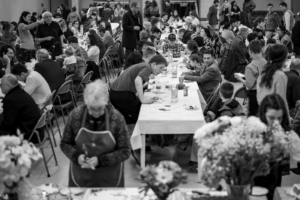You wouldn’t expect to find an article about young Catholics in National Geographic, yet there it was. The story was fascinating… and “real”. In a world increasingly dependent on electronic communications—TikTok, cell phones, video clips, etc etc, etc—to the point where it’s not uncommon to see families and couples out together yet not talking, instead each isolated in the same space, heads bent, fingers moving as each is self-consumed with cell phone games or texting. Some families are ok with texting at the dinner table, if they even eat together.
A strange new world.
But not all young people, including young Catholics, are on board. Young Catholics seek genuine happiness and human companionship, and the everything-tech world falls short. Even more, many of these young Catholics seek greater depth and beauty in the liturgy and in the lost traditions of our more than 200-year-old history.
“These devout young Catholics are embracing the old ways,” observes Matthew Teague, in his National Geographic piece.
NatGeo—In the spring of 2021 at Syracuse University, senior Ryan Brady finished his final project as an advertising major: a marketing campaign for shampoo. The bottle had a pleasing shape. The campaign had Gen Z appeal. A Fortune 100 client selected his ad strategy. But it was “complete nonsense,” he says. Not just the shampoo, but everything it represented: superficial, manipulative work. A life of consumption and extraction. An empty life. A modern life.
As a boy in Connecticut, Brady had roamed vast Wickham Park across from his family home. He couldn’t articulate it as a child, but in the woods he had felt connected with something ancient and numinous, something larger than himself. As years passed, he lost that connection.
“You pick up your phone and it’s this black touchscreen and you’re staring into the void, and it’s almost not real,” he says. “I wanted things to do that weren’t so intellectual and abstracted.”
Brady had occasionally attended a Catholic church, and he had recently heard about a new movement among some Catholics who were rebelling against modernity by worshipping in old ways, ways that centuries ago defined the faith but had almost faded from existence.
So he took up his camera and headed toward a nearby church that offered the ancient Latin Mass, or what traditionalists call the Extraordinary Form.
What he discovered as he made the photographs in this gallery often encouraged him, and sometimes unnerved him. But above all, he says, his experience was “otherworldly.”
In a counter-reformation of sorts, devout Americans are flocking to Old World traditions and beliefs. The shift seems to have surprised even the larger Catholic church itself. Last spring, Pope Francis privately told a group of Jesuits he worries the traditionalists’ “reaction against the modern” is indietrismo: backwardness.
[Many not all] Mainstream Catholics considered questions of backwardness and progress resolved after the Second Vatican Council in the 1960s. Following its reforms, priests turned to face congregations, said the Mass in common languages, and some churches offered contemporary music. The new, more accessible style became so dominant that traditionalists now see their practices as emergent and subversive.
And they’re spreading: Each week traditionalists gather at more than 1,200 sites, mostly in the United States. They embrace a version of religious life that had drifted out of fashion—the “smells and bells” of previous generations—and reach for symbols and language that bewilder the outside world … Read More, with dramatic photography here





You must be logged in to post a comment.